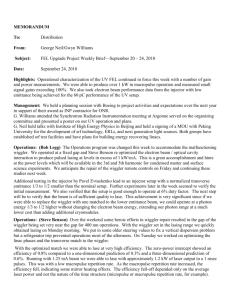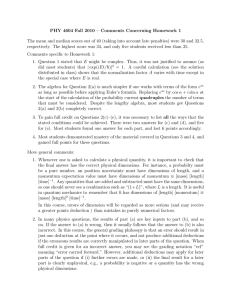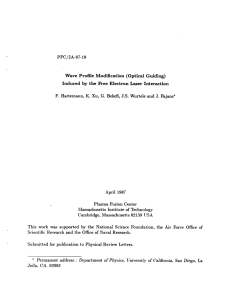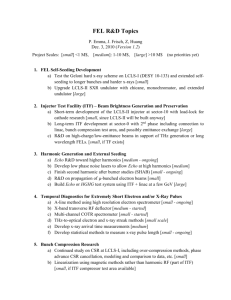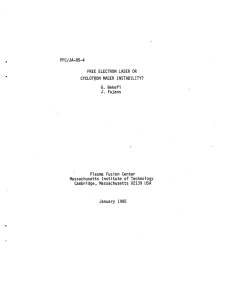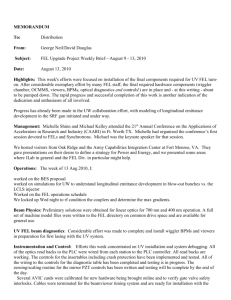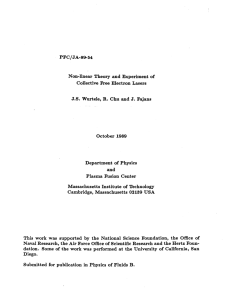PFC/JA-86-24 Nonlinear Power Saturation and Phase
advertisement
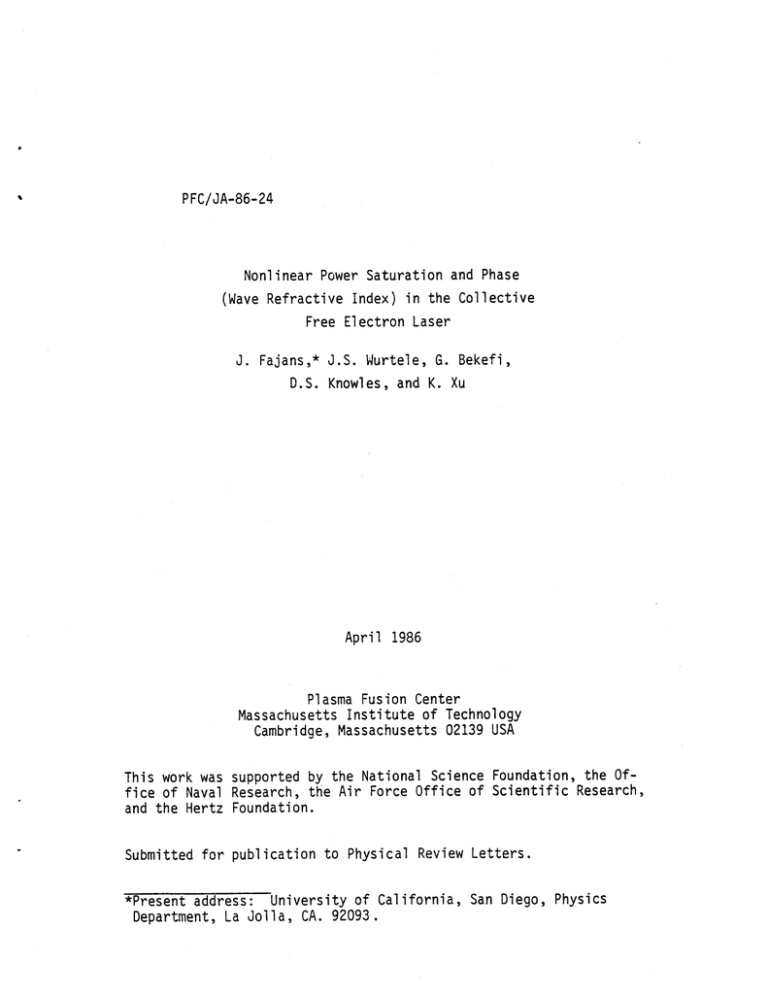
PFC/JA-86-24 Nonlinear Power Saturation and Phase (Wave Refractive Index) in the Collective Free Electron Laser J. Fajans,* J.S. Wurtele, G. Bekefi, D.S. Knowles, and K. Xu April 1986 Plasma Fusion Center Massachusetts Institute of Technology Cambridge, Massachusetts 02139 USA This work was supported by the National Science Foundation, the Office of Naval Research, the Air Force Office of Scientific Research, and the Hertz Foundation. Submitted for publication to Physical Review Letters. *Present address: University of California, San Diego, Physics Department, La Jolla, CA. 92093. Nonlinear Power Saturation and Phase (Wave Refractive Index) in the Collective Free Electron Laser J. Fajans* J. S. Wurtele, G. Bekefi, D.S. Knowles, K. Xu Department of Physics and the Plasma Fusion Center Massachusetts Institute of Technology Cambridge, Massachusetts 02139 We report measurements of the nonlinear radiation intensity and phase in a collective (Raman) regime free electron laser (FEL). The helical wiggler FEL generates up to and with an efficiency of 100KW of RF power at a frequency of 9.3GHz - 10%. The experimental measurements agree with computer simulations. PACS numbers:42.55Tb, 52.75Mb -Present address: University of California, San Diego, California 1 Free electron lasers (FELs) are currently under investigation because of several remarkable properties, including their high efficiencies and output powers, and their inherent frequency tunability. In this paper we study the power, saturation, energy bandwidth, and phase (refractive index) characteristics of a mildly relativistic, collective (Raman) regime free electron laser. The small signal linear gain behavior of the device has been investigated extensively. 1 and is now well understood. The collective (Raman) nature of the experiment has been demonstrated by determining the influence of the longitudinal space charge self-fields (beam plasma waves). In this paper the nonlinear saturation of the FEL instability is examined by observing the dependence of the FEL output power on the wiggler length, electron beam current and beam energy. We find that the output power agrees, well with the predictions of the nonlinear theory of Kroll, Morton, and Rosenbluth 2 (KMR) and others,3 ,4 when the theory is suitably extended for use with this experiment. Elsewhere, the KMR model was checked for a Cormpton regime FEL (small longitudinal self-fields) with a different wiggler 5 and waveguide configuration than ours. We also examine the change induced by the FEL interaction in the effective refractive index experienced by the electromagnetic wave. Changes in refractive index produce a cumulative phase shift in the wave which is 2) measured experimentally. Not only do phase measurements constitute an interesting test of FEL theory, but they are also relevant to the predicted phenomenon of optical guiding.6 An FEL employing optical guiding would rely on the electron beam to guide the emitted radiation in the same manner as light is guided on an optical fiber, thereby extending the FEL interaction length beyond that allowed by the Rayleigh diffraction limit. To our knowledge, the phase measurements presented here are the first such measurements to be published for any FEL. The agreement found with theory in both the linear and the nonlinear regions of operation directly confirms the FEL phase theory, albeit in a parameter regime quite different from the regime in which optical guiding is predicted to occur. The FEL is illustrated in Fig. -1. A thermionically emitting Pierce gun removed from a SLAC klystron (model 343) is energized by the Physics International Pulserad 615MR high voltage facility. The ensuing 0.25cm radius electron beam is guided magnetically into a copper plated, 2.54cm ID stainless steel evacuated drift tube which also acts as the cylindrical waveguide. Beam integrity is maintained by a uniform axial guide field Bil. Experimental measurements and electron gun computer simulationsi indicate that the beam energy spread is less than 0.5%. This, together with the relatively high current density and modest beam voltage, assures operation in the collective (Raman) regime. The 50 period circularly polarized wiggler has a period of 3.3cm, and is generated by bifilar conductors wound 3 on the drift tube. The wiggler amplitude B, is varied from zero to 300G. The FEL is operated in the amplifier mode. A microwave E-plane bend launcher superimposes the input microwave signal onto the electron beam and converts the TEO, waveguide mode of the rectangular input waveguide to a linearly polarized, TE mode of the circular guide in the FEL. At the end of the wiggler known fractions of the power in the incident and orthogonal polarizations are extracted by directional couplers, and measured by calibrated crystal detectors. The system is driven by a 1OW traveling wave tube during the small signal measurements. To saturate the FEL within approximately one meter length, a high power (- 30KW) f =9.3GHz short pulse magnetron is employed for the nonlinear studies. Figure 2 shows the FEL output-power as a function of the axial distance z for four different values of the electron beam current I and the corresponding power predicted by the computer simulations. The length of the interaction region is adjusted by an axially moveable "kicker" magnet that deflects the beam into the waveguide wall. The current varies between 0.9A and 5.5A. Since the output power and gain both decrease simultaneously when the electron beam current is decreased, the saturation length is only weakly dependent on the beam current. Past the saturation point trapped particle, electron "synchrotron" oscillations 2 cause the output power to decrease. The measured power levels are compared to the results of a computer simulation that tracks 1024 particles in a single ponderomotive 4 wavelength, The numerical model is a modification of the KMR equations. The modifications are required for the particular parameter regime of this experiment, and include corrections for the excitation of a collective space charge wave on a finite radius beam, the transverse structure of the waveguide mode,7 three-dimensional wiggler fields, the axial guide magnetic field and the mildly relativistic electron beam. Three-dimensional effects are included by using appropriately calculated input parameters and analytic expressions for the transverse electron motion.6 However, the simulation itself is one-dimensional and follows only the TEII waveguide mode. The details of the model will be reported elsewhere. The output powers shown in Fig. 2 are determined at the fixed beam voltage V that gives the greatest- gain at the beginning of the wiggler (z i 60cm). Note that this voltage need not be the voltage that gives the maximum small signal gain because the device may already be appreciably saturated at z ~ 60cm. In addition, this maximum gain voltage is not necessarily the voltage that gives the maximum output power along the entire wiggler length. In fact, the voltage that yields the maximum ouput power increases steadily for wiggler lengths longer than the saturation length. This is shown in Fig. 3 where we plot the output power as a function of beam voltage for three axial positions. We see that both in the data and in the simulations the voltage corresponding to peak power increases - 2% as z increases from 81cm to 155cm. 5 Figure 4 shows the FEL gain and the phase shift, as a function of the beam voltage, when the experiment is operating in the small signal regime. Gain is observed at the operating point where the FEL instability can be modeled as an interaction between an electromagnetic wave and an negative energy, slow space charge wave. A decrease in the output signal is obtained at a somewhat lower energy where the electromagnetic wave interacts with a positive energy, fast space charge wave. The fine structure in Fig. 4 is due to alternating constructive and destructive interference between the aforementioned waves.' This interference results from shifts in the wave phases. To directly measure these phase shifts, we use a microwave interferometer which mixes the RF output signal from the FEL with the RF input signal. As shown in Fig. 4b, the phase shifts extend over a wide range of beam energies, and they can be quite large, even when the FEL gain is near unity. A characteristic of the collective (Raman) regime is that the phase shift is near zero when the FEL interaction is strongest (i.e. at the large maximum and minimum of Fig. 4a). This behavior is quite different from the phase behavior of an FEL operating in the single particle (strong pump Compton) regime, where the phase shift is largest at maximum gain. In Fig. 5a we show the phase shift as a function of distance within the wiggler. The FEL power saturates at z - 100cm. However, even in the saturated regime the phase continues to change, thus demonstrating 6 continued bunching of the electron beam by the FEL interaction. In Fig. 5b and c we plot the power and phase shift as a function of beam voltage at a fixed distance z = 104cm. We note that the phase shifts illustrated in Figs. 4 and 5 are relative to the phase the electromagnetic wave would have in the absence of the FEL interaction. A positive shift denotes a reduction in the phase velocity of the wave, and thus an increase in the effective refractive index, and vice versa for a negative phase shift. In conclusion, we have studied the power saturation of a collective free electron laser. The experimental results are in very good agreement with the predictions of an extended one dimensional numerical model which includes the essential three dimensional physics for this experiment. We have also studied the phase behavior of-the FEL, and find that these measurements are also correctly predicted by the FEL theory. Such measurements are a good test of nonlinear FEL theory, and they are also relevant to the predicted phenomenon of optical guiding. This work was supported by the National Science Foundation, the Office of Naval Research, the Air Force Office of Scientific Research, and the Hertz Foundation. 7 References 'J. Fajans, G. Bekefi, Y. Z. Yin, and B. Lax, Phys. Rev. Lett. 53, 246 (1984) and Phys. Fluids 26, 1995 (1985). 2 N. M. Kroll, P. L. Morton, and M. R. Rosenbluth, IEEE J. Quantum Electron. QE-17, 1436 (1981). 3W. B. Colson, IEEE Jour. Quantum Electron. QE-17, 1417 (1981). 4 D. Prosnitz, A. Szoke, and V. K. Neil, Phys. Rev. A 24, 1436 (1981). sT. J. Orzechowski, E. T. Scharlemann, B. Anderson, V. K. Neil, W. M. Fawley, D. Prosnitz, S. Yarema, D.B. Hopkins, A. C. Paul, A. M. Sessler, and J. S. Wurtele, IEEE Jour. Quan. Electron. QE-21, 831 (1985). 'E. T. Scharlemann, A. M. Sessler, and J. S. Wurtele, Phys. Rev. Lett. 54, 1925 (1985). 7 J. S. Wurtele, E. T. Scharlemann, and A. M. Sessler, to be published in the Proceedings of the Seventh Annual Free Electron Laser Conference, Tahoe City, California 1985. 'H. P. Freund, S. Johnston, and P. Sprangle, IEEE J. Quant. Electron. QE-19, 322 (1983). 'J. Fajans and G. Bekefi, submitted for publication in Phys. Fluids. 8 Figures FIG. 1. Schematic of the collective FEL experimental set-up. FIG. 2. Microwave power as a function of wigger length z for four currents, with B, = 188G, Bj = 1512G, and f = 9.3GHz. The points are from experiment, the lines from simulation: o o I = 5.5A; E 4+ I = 3.7A; I = 2.5A; AA I = 0.9A. FIG. 3. Power as a function of beam energy for three values of wiggler length z. The solid lines are from the experiment,the dashed lines are from simulation. Here B, = 187G, B11 = 1470G, I = 4.5A, Pi = 32KW and f= 9.3GHz. FIG. 4. The small signal gain and relative phase shift as a function of beam voltage. The solid lines are from the experiment,the dashed lines are from theory. 9 B, = 122G, B1 = 1510G, I = 3.5A, f = 11.1GHz. FIG. 5. Nonlinear phase measurements; (a) phase vs. z at -y = 1.301; (b) phase vs voltage at z = 104cm; (c) power vs. voltage at z = 104cm. The solid lines are from the experiment,the dashed lines are from simulation. B, = 176G, B11 = 1450G, I = 4.1A, Pin = 27KW and f = 9.3GHz. 9 .J a 2I I9 (-L aJr~ I z LU LU I- Lu aLUJ cDJ (I) 00 U LUJ LUJ z DJ z 0 ULU z 0 L w U- M- 110 90- + ++ + + ++ +- /+ + 0 + w+ > mass 50- + '/ w A A A& AAAA is--- 30 - - 0 40 80 z (cm) 120 160 Fig. 2 Fajans et al I I (a) 80- 40 z=81cm 0 (b) 40 - 40- (C)C cm z=155 S1.291 1.296 BEAM VOLTAGE 1.301 1.306 l+ Fig. 3 Fajans et a] 3.0 z I 2.0 (a) - - LI- 0- a- ----- 1.0 - - ---- - -- ---- \ - 08 0 06 I - 0.4 0 0.2 +300 \ (b) I.- + 2(Y +. 0*o - w - 0 -\0' -20' I 0.8 I 0.9 1.0 I. NORMALIZED VOLTAGE Fig. 4 Fajans et al O*r -p (a) waf - 1%e - * -4d' 0 50 90 170 130 Z (cm) (b) 0- -40 80 -- (c) woo Lii 40 0 I 01 1.288 I I I 1.294 1.300 1.306 BEAM VOLTAGE Y=1+eV/moc 2 Fig. 5 Fajans et al
